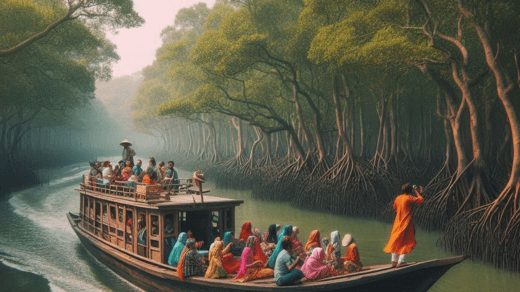The Sundarbans is one of the most fascinating natural landscapes in the world. Known for its rich biodiversity and the world’s largest mangrove forest, this UNESCO World Heritage site offers a unique blend of wilderness and beauty. Located at the confluence of the Ganges, Brahmaputra, and Meghna rivers, the Sundarbans spans across India and Bangladesh, with the majority of the forest located in India.
A Sundarban trip is perfect for anyone seeking adventure, tranquility, and a connection with nature. Whether you’re an avid wildlife enthusiast, a nature lover, or someone looking for a peaceful escape, this trip will provide you with a remarkable experience.
1. What Makes Sundarban Special?
The Sundarbans is not just a forest; it’s a mysterious world full of incredible wildlife, mangrove ecosystems, and vast rivers that create a landscape unlike any other. The dense mangroves are home to the famous Royal Bengal Tiger, sundarban trip the world’s only tiger species known to thrive in such an environment. Along with tigers, the Sundarbans is also home to saltwater crocodiles, spotted deer, wild boars, and an array of exotic bird species.
2. How to Get There
To begin your Sundarban trip, travelers typically start from Kolkata, the nearest major city. From there, it’s about a three-hour drive to various embarkation points like Godkhali or Sonakhali. From these points, boats are used to explore the Sundarban forest. The journey through rivers and creeks itself is a magical part of the trip.
3. Best Time to Visit Sundarban
While the Sundarbans can be visited year-round, the best time to plan your Sundarban trip is between November and March. The weather during these months is cool and pleasant, making it ideal for wildlife sightings and boat tours. Avoid visiting during the monsoon season, as the heavy rains can make it difficult to explore the area.
4. The Wildlife Safari Experience
The highlight of any Sundarban trip is undoubtedly the wildlife safari. With a chance to spot the elusive Royal Bengal Tiger, the excitement is palpable. Although spotting a tiger is rare due to the dense mangroves, visitors can often see tiger footprints along the muddy banks of the rivers. Wildlife enthusiasts can also enjoy birdwatching, as the forest is home to species like the kingfisher, herons, and the rare masked finfoot.
5. Exploring the Mangroves
The mangrove ecosystem of the Sundarbans is a spectacle in itself. Known as the largest tidal halophytic mangrove forest in the world, the mangroves create a dense labyrinth of trees and roots that stretch into the river. The intricate root system not only supports the ecosystem but also plays a vital role in protecting the coastline from erosion and storms.
6. Boat Cruises
A unique aspect of the Sundarban trip is the boat cruise experience. Since much of the forest is accessible only by water, travelers spend most of their time exploring on boats. These slow boat rides take you through narrow creeks and wide rivers, offering serene views of the forest and occasional sightings of wildlife. Staying overnight on the boat is also an option, with meals and accommodation provided onboard.
7. Sundarban National Park
Part of the larger Sundarban Biosphere Reserve, Sundarban National Park is a must-visit for those on a Sundarban trip. The park offers guided tours where you can explore the rich biodiversity of the area. From crocodiles basking in the sun to deer grazing near the water’s edge, the park is a prime location for nature lovers.
8. Local Villages and Culture
A Sundarban trip also gives visitors the opportunity to explore local villages. The people living in the Sundarban region have a unique way of life, heavily influenced by the rivers and forests around them. Visiting these villages allows travelers to experience local culture, traditional fishing techniques, and even witness religious festivals dedicated to forest deities like Bonbibi, who is believed to protect the people from tigers.
9. Flora and Fauna of the Sundarbans
The Sundarbans is home to over 300 plant species, most of which are unique to the mangrove ecosystem. Among these, the Sundari tree (from which the forest derives its name) is the most notable. The region also boasts a rich variety of animals, including aquatic mammals like river dolphins, and reptiles like the monitor lizard.
10. Adventure and Eco-Tourism
For the adventurous traveler, a Sundarban trip offers more than just wildlife safaris. Travelers can engage in eco-tourism activities like kayaking, fishing, and even jungle trekking with experienced guides. These activities not only offer an adrenaline rush but also allow you to engage closely with nature.
11. Conservation Efforts
Due to its unique biodiversity, the Sundarbans has been the focus of various conservation efforts. The Royal Bengal Tiger, in particular, is endangered, and multiple organizations work to protect these majestic creatures. Visitors can learn more about these conservation projects while on their Sundarban trip, contributing to eco-friendly tourism.
12. Photography Opportunities
Photographers will find the Sundarbans an ideal location to capture the wild beauty of nature. Whether it’s the striking sunset over the rivers, the dense mangrove forests, or rare wildlife sightings, every corner of the Sundarbans offers breathtaking views and photographic moments.
13. Sundarban Packages
There are many tour packages available for a Sundarban trip, ranging from one-day tours to multiple-day expeditions. These packages include boat cruises, guided tours, accommodation, and meals. Whether you’re looking for a budget-friendly trip or a luxurious experience, there’s something for every traveler.
14. Tips for a Safe Sundarban Trip
While the Sundarbans is a place of beauty, it’s also a wild and untamed environment. Visitors should always follow the instructions of their guides, avoid venturing into restricted areas, and wear appropriate clothing to protect against mosquitoes and other insects.
15. Eco-Friendly Travel in Sundarbans
Eco-friendly tourism is essential when visiting sensitive ecosystems like the sundarban tour package. Travelers are encouraged to reduce their carbon footprint by avoiding plastic, conserving water, and supporting local conservation efforts during their Sundarban trip.
16. Day and Night in Sundarbans
One of the most beautiful aspects of a Sundarban trip is witnessing the forest’s transformation from day to night. During the day, the mangroves are vibrant with life, while at night, the forest takes on an eerie calm, with only the sounds of nature echoing through the dark.
17. Accommodation Options
There are various accommodation options available during a Sundarban trip, from basic eco-lodges to more comfortable resort-style stays. Some tours also offer the option of staying on the boat, allowing travelers to sleep under the stars surrounded by the beauty of the forest.
18. Local Cuisine
A Sundarban trip would be incomplete without tasting the local cuisine. Dishes made with fresh fish, prawns, and other seafood are the highlights. The local Bengali food is simple but flavorful, offering a true taste of the region.
19. Sustainable Travel
Visitors are encouraged to practice sustainable travel during their Sundarban trip. This means supporting local businesses, minimizing waste, and respecting the natural environment and wildlife.
20. A Memory to Cherish
A Sundarban trip is more than just a vacation; it’s a journey into one of the world’s most enchanting wilderness areas. Whether you’re captivated by the wildlife, mesmerized by the mangroves, or touched by the simplicity of village life, the memories of this trip will stay with you forever.






